- Catalogue Plants
Ostrya carpinifolia 30-70cm
Ostrya carpinifolia 30-70cm
Regular price
€12,00 EUR
Regular price
Sale price
€12,00 EUR
Unit price
per
Tax included.
Shipping calculated at checkout.
Couldn't load pickup availability
Plant Description
IMPORTANT: Please be aware that picture 1 show adult plant not for sale, the offer is for a plant in the dimension indicated in title description.
Botanical family: Betulaceae
Botanical genus: Ostrya
Botanical species: Ostrya carpinifolia
SKU:BA-0974-S
Cultivation
Cultivation
Info and Disclaimers
Info and Disclaimers
Plant Height: 30-70cm
Plant Diameter:
Pot Size:
Grafted/Not Grafted:
Disclaimer: Be aware that most plants change across seasons. If present foliage, could have been fallen or change in its color.


